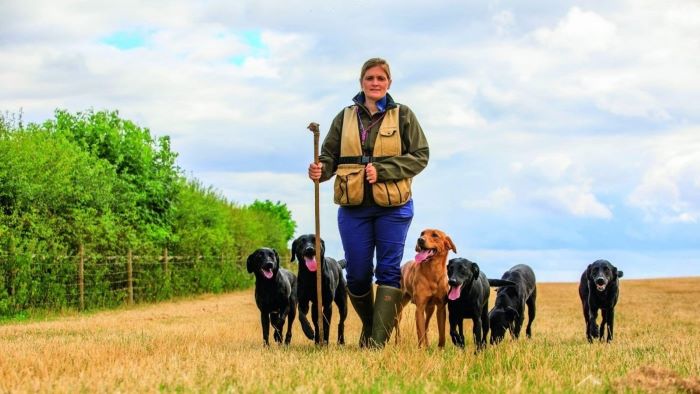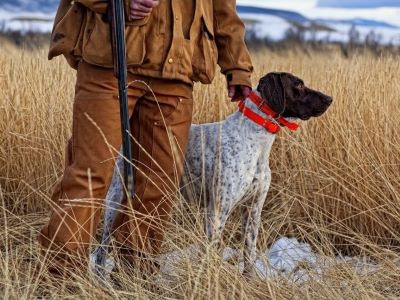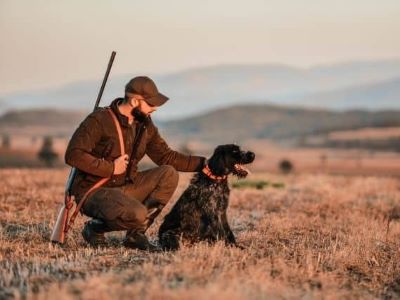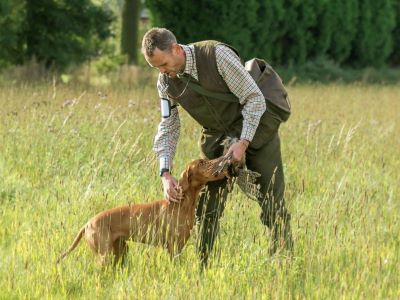Being with a gun is an exciting adventure, especially training with them, but “What age to start gun dog training?” Training them sharpens their natural talents for hunting and tracking.
In this blog, we are going to understand the right age for gun dog training and how can you do that in a way that improves your bond with your dog. Here we begin!

What Age to Start Gun Dog Training?
Training your gun dog is one of the most incredible feelings in the world. Just like us dogs too go through different stages of growth in their life. Let’s see these stages and how to train them according to these stages:
1. Puppies (8-12 weeks)
Think of your puppy as someone who went to an adventure park for the first time, they feel excited and happy about everything. Same way take your puppy to various places: parks, streets, and maybe a friend’s house, so they can get used to all kinds of sights, sounds, and smells[1].
After they feel comfortable then you can start with the basic training like "sit" (asking them to sit down), "stay" (telling them to wait), and "come" (calling them to you).
Use rewards like treats and lots of happy words to show them they’re doing a great job, “Good Boy!” goes the long way.

2. Adolescence (3-6 months)
Obedience training is the next adventure after the ABCs of training, like learning different exciting words.
- Here’s what’s happening: Just like practising the basics in any subject, you’re reinforcing commands like “sit,” “stay,” and “come.” To make sure they understand and follow these commands.
- Now we move to other commands like, “Heel” means walking nicely beside you, “Retrieve” is like teaching them to bring things back to you, preparing them for more complex tasks ahead.
- Again, treats and praise are the rewards for their exceptional performance. Dogs naturally love to fetch, and during this phase, you’re using soft toys to encourage this instinct.
- Toss a toy, and when your dog brings it back, celebrate! It’s like a fun game of catch. Keep these play sessions short and exciting. It’s like playing a quick game of catch in the backyard.
During this phase, consider using a gun dog slip leads to reinforce the 'heel' command and teach your dog to walk nicely beside you.
3. Young Adulthood (6-12 months)
Now, start using objects that resemble hunting tools or dummy guns. It’s like going from training wheels to a real bike, a step towards the tasks they’ll do in the field.
Just as you wouldn’t dive into deep water without learning to swim, slowly transition your dog to retrieving more realistic objects. This helps them to be comfortable with various sizes and shapes of the subject they may encounter during the hunting.
If there is water around you then it is important to teach them to swim too, it’s like testing the waters (Literally!) Start with shallow areas, before moving to deeper waters.
Make this a positive experience and praise them into the water, take it slow and steady. Make sure they feel confident and happy.

4. Adult Stage (1 year and older)
This is THE MOMENT, introduce them to the world of gun sounds by starting with softer noises like starter pistols or blanks. This is like practising in a rehearsal room before a big performance.
Choose a quiet, safe place for these sessions. This helps your dog connect the noise with a secure environment, making them more comfortable with it over time. Up the game by introducing more challenging retrieves.
This could be different terrains, varying distances, or even objects with unique shapes. In the world of gun dogs, steadiness is like having a cool head in any situation.
Train your dog to stay calm and composed, especially during exciting moments like retrieving or simulated hunting. It’s like turning them into the James Bond of the dog world: reliable and calm.
5. Continued Training
Continued training is like the test paper, if you get it right one time then keep practising to get it right most of the time.
This consistency reinforces what they’ve learned and helps them remember commands and behaviours. Training sessions aren’t just about skills; they’re also about building a strong friendship.
Every command followed correctly is a success, this keeps your dog sharp, and ready to apply their skills in the field.

Tips for Successful Gun Dog Training
Let’s look at some Tips for Successful Gun Dog Training in detail:
- Training is a journey, not a race. Imagine you’re teaching a friend a new dance. You’d be patient, right? Dogs are the same, they need time to learn the steps. If they don’t get it right away, it’s okay. Keep practising!
- Positive reinforcement is something awesome. Saying, “Great job! You’re amazing!” When your dog follows a command or retrieves something correctly, give them a treat or lots of praise. It’s like saying, “You did it! Here’s a tasty treat!”
- Dogs like routines. Set a regular time for training sessions. It could be a short daily routine. Dogs are like little planners, they love knowing when it’s “training time.”
- Consider joining a gun dog training class, learning from a pro is like having a coach for your team. Trainers are like mentors who can guide you and your dog. They’ve been there, done that, and can provide special tips for your dog’s unique journey.
FAQs
Where Do You Start Training a Gun Dog?
Start by giving your dog a training dummy whenever they greet you in the morning. Then, take it back off them before they drop it and give them plenty of attention. You can also start leaving dummies around the house for your dog to bring to you in the morning or whenever you return home.
What Age to Start Gun Dog Training?
When to begin gundog training. Whilst you’ll hear various opinions of when to start gundog training, the general view is to begin when they reach between 6 – 8 months of age. Remember that every dog is different, and while some pups may take to it with ease, others might find it a bit more of a challenge.
What Is the Easiest Gun Dog to Train?
Curly Coat Retriever. They are great all-rounder dogs that can be trained to serve in nearly any role, including hunting, fieldwork, and retrieving. Curly-coated Retrievers have equally balanced sizes and structures that make them very easy to train.
How Do You Exercise a Gun Dog?
So heel the dog along a track. Stop and leave the dog in a stay, walk ten yards or so in front, make sure the dog is watching, and throw a dummy up the track. Walk back to your dog, slip the lead on if you don’t trust him to turn and heel away from the dummy with you, then walk maybe twenty yards down the track.
How Much Exercise Do Gun Dogs Need?
Working dogs and gun dogs need the most exercise. At least 30 minutes of hardcore activity in addition to their 2-3 hours a day. Don’t forget our non-sporting dogs! Originally bred to work but now more commonly found as family pets.
Conclusion
In conclusion “What age to start gun dog training?” Training your puppy improves their natural gifts and both of you end up coming closer than ever.
Training your gun dog is one of the most incredible feelings in the world, nurturing your dog’s natural talents from a young age, you develop communication, trust, and respect between both members of the team.
Following a training plan with patience and positivity makes this journey smooth. Celebrate each milestone (small wins too), here is to a happy training!
Reference:
- Donovan, L. (2022, July 7). Puppy socialization: why, when, and how to do it right. American Kennel Club.



